
The West Jackson Boulevard District in Chicago, Illinois, also known as West Jackson Historic District, was listed on the National Register of Historic Places in 1978. It was earlier designed as a Chicago Landmark, in 1976, and expanded as Jackson Boulevard District and Extension in 1997. The NRHP district was expanded in 1989 to include one more building, the James H. Pearson House.

Charles W. Van De Mark House is a Queen Anne style historic building located in Clyde, Kansas, which is listed on the National Register of Historic Places. It was listed in 1985. It was deemed notable " local architectural significance as one of the most elaborate and best preserved of the late nineteenth-century houses of Clyde."

U.S. Route 64 is a U.S. highway running from Teec Nos Pos, Arizona east to Nags Head, North Carolina. In the U.S. state of Arkansas, the route runs 246.35 miles (396.46 km) from the Oklahoma border in Fort Smith east to the Tennessee border in Memphis. The route passes through several cities and towns, including Fort Smith, Clarksville, Russellville, Conway, Searcy, and West Memphis. US 64 runs parallel to Interstate 40 until Conway, when I-40 takes a more southerly route.
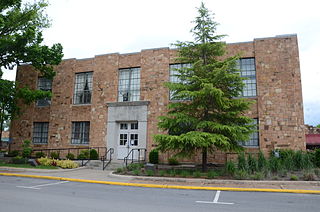
The Van Buren County Courthouse is located at the corner of Griggs and Main Streets in downtown Clinton, Arkansas, the county seat of Van Buren County. It is a two-story masonry structure, built primarily out of local stone. Its main facade is five bays wide, each flanked by broad sections that project a small amount. The main entrance is in the center bay, with a concrete surround of pilasters and a tall corniced entablature. It was built in 1934 with funding support from the federal Works Progress Administration, and was the county's third courthouse to be located in Clinton.

The Ragland House is a historic house at 1617 South Center Street in Little Rock, Arkansas. It is a 2-1/2 story wood frame structure, with asymmetrical massing characteristic of the Queen Anne period. Its exterior is elaborately decorated with bands of cut shingles on the second level, and a bulbed turret at one corner. A single-story porch wraps around the tower to the side, with a jigsawn valance and Stick style balustrade. Built about 1891–92, it is unusual as an early work of the noted Arkansas architect Charles L. Thompson, who is better known for more Colonial Revival designs. The house was built for Mr. and Mrs. William Ragland. After the Raglands moved, Mrs. Ragland's parents, Edmond and Henriette Urguhart lived there until his death in 1905.

The Breckwoldt-Ward House is a historic house located at 90 Van Buren Street in Dolgeville, Herkimer County, New York.

The Van Buren Historic District encompasses eight blocks of historic buildings along Main Street in Van Buren, Arkansas. Many of the structures are pre-1920 Victorian and Italianate buildings closely related to the history of commerce in the city. Positioned between the city's train depot and the Arkansas River, the businesses constituting the Van Buren Historic District have played a vital role in the history and economy of the city and region. The district was placed on the National Register of Historic Places as a National Historic District on April 30, 1976.

The Henry McKenzie House, also known locally as the Dalrymple House, is a historic house at 324 East Main Street in Prescott, Arkansas. The two story wood frame house was built in 1902 by Henry McKenzie, and is said to have been designed by Charles L. Thompson, although there is no supporting evidence for this claim. The house is one of the best-kept transitional Queen Anne/Colonial Revival houses in Prescott, with decorative shingle siding in its gable ends and diamond-pane windows. Its most significant alteration was the removal of Ionic columns from its porch during renovations in the 1950s which including enclosing the porch.

The Dr. Charles Fox Brown House is a historic house at 420 Drennan Street in Van Buren, Arkansas. It is a single story brick structure, whose main block is five bays wide, with a small secondary block set back from the front at the left, and an ell extending to the rear. It has a side-gable roof, with a front-facing gable above the centered entrance, which is further sheltered by a flat-roof portico supported by four columns. The eaves are studded with brackets, and there are a pair of round-arch windows in the front-facing gable. The house was built in 1867 for Dr. Charles Fox Brown, and is unusual for the original 19th-century surgery, located in the secondary block. The house is stylistically a distinctive blend of Greek Revival and Italianate styles.
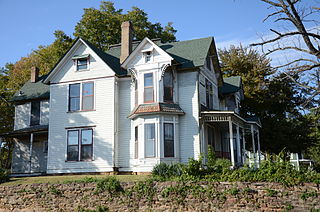
The Bryan House is a historic house at 105 Fayetteville Street in Van Buren, Arkansas. Built in 1886, it is one of the city's finest Queen Anne Victorian houses, with asymmetrical massing, multiple gables and projecting bay sections, and elaborate exterior decoration. The interior also has well-preserved woodwork, hardware and other decoration. The house was built by Lewis Bryan as a summer house, and is notable beyond its architecture as the local headquarters for Bryan's cousin William Jennings Bryan during his runs for President of the United States.
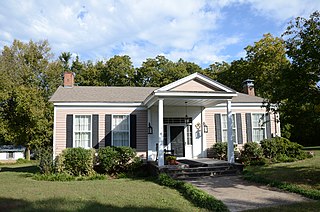
The Clarke–Harrell–Burson House is a historic house at 603 Parkview in Van Buren, Arkansas. It is a single-story wood frame structure with Greek Revival styling, built about 1841, and is believed to have been the first non-log house built in the area known as Logtown that is now part of the city of Van Buren. The house is locally notable for several prominent residents: George Washington Clarke was the publisher of Arkansas's first newspaper west of Little Rock, the Intelligencer, which began publication in 1842 and was taken over by Clarke in 1844. The house's next owner, the Rev. Jonathan Harrell, was the first Methodist minister in the region, and a founding member of the Arkansas Methodist conference. Later in the 19th century it was owned by Dr. Edward Burson, a veteran of the American Civil War and a prominent local dentist.

The Drennen-Scott House is a historic house museum on North 3rd Street in Van Buren, Arkansas. It is a single-story log structure, finished in clapboards, with a side-gable roof that has a slight bell-cast shape due to the projection of the roof over the front porch that extends across the width of its main block. The house was built in 1836 by John Drennen, one of Van Buren's first settlers. Drennen and his brother-in-law David Thompson were responsible for platting the town, and Drennen was politically active, serving in the territorial and state legislatures, and at the state constitutional convention. The house remained in the hands of Drennen descendants until it was acquired by the University of Arkansas at Fort Smith, which operates it as a house museum.

The Joseph Starr Dunham House is a historic house at 418 Broadway in Van Buren, Arkansas. Built c. 1870, this 1-1/2 story wood frame house is a fine local example of Gothic Revival architecture, with a steeply-pitched side-gable roof that has front-facing gable dormers decorated with sawn woodwork, and a full-width front porch with spiral posts and delicate brackets. Joseph Starr Dunham, the owner, was a Connecticut native who settled in Van Buren in 1859 and began publishing the Van Buren Press; the house was still in family hands when it was listed on the National Register of Historic Places in 1976.
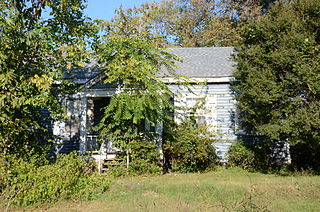
The Wilhauf House is a historic house at 109 North 3rd Street in Van Buren, Arkansas. Built in 1838 and restyled in 1847, it is one of the oldest surviving buildings in the state. It is a single story log dog trot structure, consisting of two log pens originally joined by a breezeway. The house is sheathed in weatherboard, and has a modest Greek Revival gabled portico. The 1847 alterations included the extension of the gable roof to accommodate additional rooms in the rear, which have been furthered extended by a modern addition. The house was built by Leonard Wilhauf on land he purchased from John Drennan, Van Buren's first proprietor.

The Henry Clay Mills House was a historic house at 425 North 15th Street in Van Buren, Arkansas. This modest frame house was built in 1892 by Henry Clay Mills, an African-American former slave turned businessman. Mills was born into slavery in 1847, and after the American Civil War worked for many years as a laborer on a plantation near Mulberry. He eventually developed a moving and shipping business in Van Buren, typifying advancement of African-Americans of the period from agricultural to non-agricultural economic opportunities.
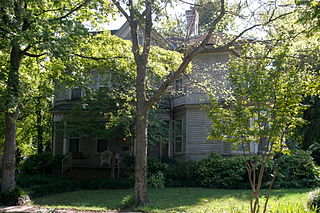
The Empie-Van Dyke House is a historic house at 403 Laurel Street in Newport, Arkansas. It is a two-story wood frame structure, with the asymmetrical massing typical of the Queen Anne style. It has two projecting sections, one at a corner that is topped by a pyramidal tower. Built in 1891, it was one of the first Queen Anne houses built in the city, and is one of its few older homes to survive with little alteration. It was built by William B. Empie, owner of local lumber-related businesses, and survived the town's great 1927 flood.

The Stewart House is a historic house at 1406 Summit Street in Little Rock, Arkansas. It is a 1-1/2 story wood frame structure, with a distinctive blend of Queen Anne and Colonial Revival styling. It was built about 1910 to a design by Arkansas architect Charles L. Thompson. Its asymmetric massing, with a high hipped roof and projecting gables, is typically Queen Anne, as are elements of the front porch. Its Ionic columns and dentillate cornice are Colonial Revival.

The Van Buren County Road 2E Bridge is a historic bridge in rural southwestern Van Buren County, Arkansas. It is a three-span open concrete masonry structure, with each span measuring 12 feet (3.7 m) in length, carrying County Road 2E across an unnamed tributary of Driver's Creek. The bridge rests on piers and abutments of stone and concrete, and has a roadway deck 19.9 feet (6.1 m) wide. It was built in 1940 with funding from the Works Progress Administration, and is a well-preserved example of a period concrete bridge.

The East Michigan Avenue Historic District is a residential historic district located at 300-321 East Michigan Avenue, 99-103 Maple Street, and 217, 300 and 302 East Henry in Saline, Michigan. It was listed on the National Register of Historic Places in 1985.

The Northwest Side Historic District is residential district in central Stoughton, Wisconsin, United States with 251 contributing homes built from 1854 to 1930. In 1998 the neighborhood was listed on the National Register of Historic Places.





















